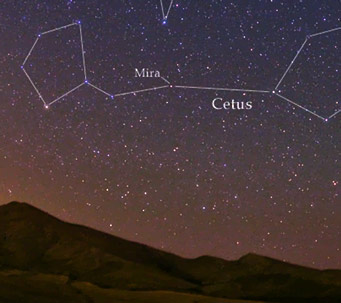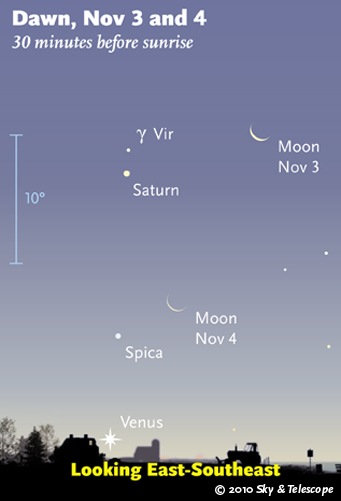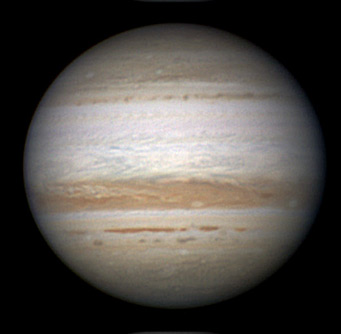Friday, October 29

Now at naked-eye visibility, Mira in Cetus climbs the eastern sky in late evening — in this case, over hills in Iran.
Babak A. Tafreshi
Saturday, October 30
Sunday, October 31

Comet Hartley 2, big and round but very dim, crosses the feet of Gemini early this week rapidly heading south. Click image for larger map.
Sky & Telescope diagram
Monday, November 1
Tuesday, November 2

Early risers can catch the waning crescent Moon guiding the way to Saturn, Spica, and Venus as dawn grows bright. bring binoculars; the visibility of objects in bright twilight is exaggerated here. The blue 10° scale is about the size of your fist held at arm's length.(These scenes are drawn for the middle of North America. European observers: move each Moon symbol a quarter of the way toward the one for the previous date.)
Sky & Telescope diagram
Wednesday, November 3
Thursday, November 4
Friday, November 5
Saturday, November 6
Sky at a Glance is now an iPhone app! Put S&T SkyWeek on your iPhone, iPad, or iPod Touch and get the above listings anytime, anywhere — with interactive sky maps! Tap a button to see the scene described, customized for your location worldwide. From there you can scroll the view all around the sky, zoom in or out, change to any time or date, and turn on animation! Go to Apple's iTunes store from your device and buy S&T SkyWeek — for just 99 cents!
Want to become a better amateur astronomer? Learn your way around the constellations. They're the key to locating everything fainter and deeper to hunt with binoculars or a telescope.
For an easy-to-use constellation guide covering the whole evening sky, use the big monthly map in the center of each issue of Sky & Telescope, the essential magazine of astronomy. Or download our free Getting Started in Astronomy booklet (which only has bimonthly maps).

The Pocket Sky Atlas plots 30,796 stars to magnitude 7.6 — which may sound like a lot, but that's less than one star in an entire telescopic field of view, on average. By comparison, Sky Atlas 2000.0 plots 81,312 stars to magnitude 8.5, typically one or two stars per telescopic field. Both atlases include many hundreds of deep-sky targets — galaxies, star clusters, and nebulae — to hunt among the stars.
Sky & Telescope
Once you get a telescope, to put it to good use you must have a detailed, large-scale sky atlas (set of charts). The standards are the Pocket Sky Atlas, which shows stars to magnitude 7.6; the larger Sky Atlas 2000.0 (stars to magnitude 8.5); and the even larger and deeper Uranometria 2000.0 (stars to magnitude 9.75). And read how to use your charts effectively.
You'll also want a good deep-sky guidebook, such as Sky Atlas 2000.0 Companion by Strong and Sinnott, or the more detailed and descriptive Night Sky Observer's Guide by Kepple and Sanner, or the classic if dated Burnham's Celestial Handbook.
Can a computerized telescope take their place? I don't think so — not for beginners, anyway, and especially not on mounts that are less than top-quality mechanically. As Terence Dickinson and Alan Dyer say in their Backyard Astronomer's Guide, "A full appreciation of the universe cannot come without developing the skills to find things in the sky and understanding how the sky works. This knowledge comes only by spending time under the stars with star maps in hand."
This Week's Planet Roundup
Mercury and Venus are still deep in the glow of the Sun. Late in the week Venus begins emerging into view very low in the east-southeast in bright dawn, as shown above.
Mars, dim at magnitude +1.4, continues to linger very low in the southwest after sunset. Use binoculars to scan for it early in twilight. Look also for fainter Antares twinkling to Mercury's left or lower left.

The non-Red-Spot side of Jupiter is interesting too, as seen in this image taken at 11:35 UT November 3rd. South is up. The South Equatorial Belt is still missing. The North Temperate Belt remains broad and dark with diagonal disturbances. Below it, is the North Temperate Belt broken into pieces, or are we seeing lots of red-brown "barges" merging together?
Don't expect an eyepiece view this sharp and steady any telescope, no matter how big! Planetary imager Christopher Go continues to demonstrate the extraordinary power of stacked-video imaging done with years of experience.
Jupiter (magnitude –2.8, at the Pisces-Aquarius border) shines high in the southeast to south during evening. It's by far the brightest starlike point in the sky. In a telescope it's still a big 47 arcseconds wide.
Jupiter's Great Red Spot is near System II longitude 157°. Assuming it stays there, here's a list to print out of all the Great Red Spot's predicted transit times for the rest of this observing season.
Saturn (magnitude +0.9, in Virgo) is low in the east-southeast in early dawn. Don't confuse it with brighter Arcturus far to its left. The best time to try observing Saturn with a telescope is in moderately bright morning twilight, perhaps an hour before your local sunrise time, when the planet will be less blurred by the low-altitude atmospheric mess. Saturn's rings have widened to 8° from edge-on.
Uranus (magnitude 5.8) is 3° east of Jupiter.
Neptune (magnitude 7.9, in Capricornus) is highest in the south in early evening. See our finder charts for Uranus and Neptune online, or with article in the September Sky & Telescope, page 56. Can you see any color in Uranus and/or Neptune?
Pluto (magnitude 14.0, in Sagittarius) is disappearing in the southwest after dark.
All descriptions that relate to your horizon — including the words up, down, right, and left — are written for the world's mid-northern latitudes. Descriptions that also depend on longitude (mainly Moon positions) are for North America. Eastern Daylight Time (EDT) equals Universal Time (also known as UT, UTC, or GMT) minus 4 hours.
To be sure to get the current Sky at a Glance, bookmark this URL:
http://SkyandTelescope.com/observing/ataglance?1=1
If pictures fail to load, refresh the page. If they still fail to load, change the 1 at the end of the URL to any other character and try again.
 0
0
Comments
You must be logged in to post a comment.